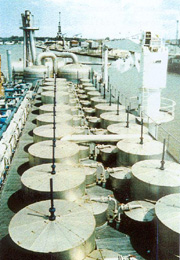Solar Seawater Desalination
How It Works
Parabolic Trough Collectors are concentrating solar radiation to achieve 230° C steam temperature. A heat accumulator is charged to provide steam 24 hours a day to the multi-effect seawater desalination system, which requires an uninterrupted steam supply. A backup provides minimum steam during bad weather periods.
Parabolic Trough Collectors are tracking the sun to achieve a highly concentrated solar radiation. The Absorber Tube in the focus converts the radiation into heat.
The Heat Accumulator is a vessel, which is filled with pressurised water at the boiling point. Steam is generated when the system pressure is reduced.
The multi-effect desalination system is a highly efficient distiller, which recycles the heat internally to achieve a maximum performance. The advantage of the multi-effect process is the flexible operation and the low minimum steam demand for operation during cloudy weather.
References
Operation experience: Parabolic Trough Collectors since 1980; heat accumulator since 1920 and multi-effect distillation since 1970.

The operating and maintenance costs are very low as the sun provides energy free of charge. The system will operate for many years due to the extended life expectancy of the components.
Technical Data
Solar field
Ruths storage heat accumulator
Heat storage
multi-effect distiller with maximum GOR
Distiller
12,000 m³/day
per km²
Performance
fuel or gas
Backup
120 tons per day
CO2 savings
We are offering accurate planning and simulation of the yearly solar performance to reduce the investment in the solar seawater desalination system and to minimize the required backup.
